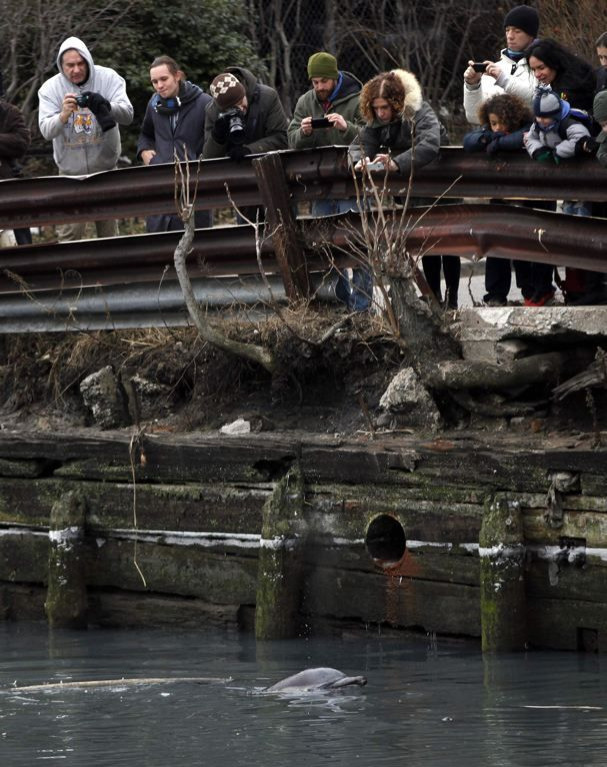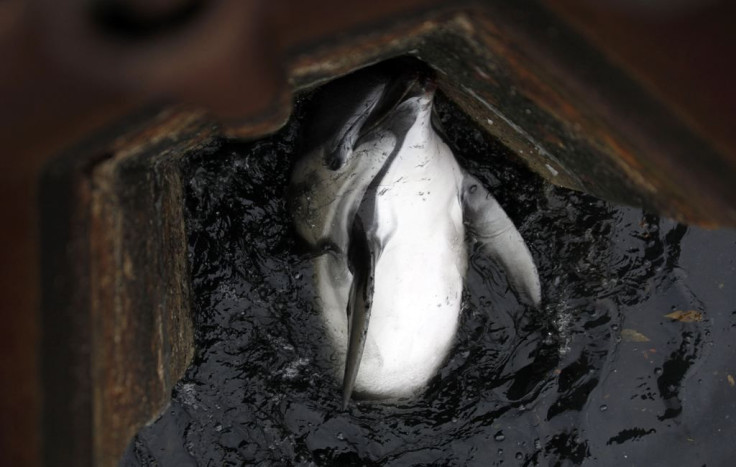Gowanus Dolphin Already Doomed Before It Entered Polluted Canal, Necropsy Reveals [PHOTOS]
The dolphin that perished in the waters of the Gowanus canal wasn’t killed by the polluted waters of the Brooklyn waterway -- it was already severely sick and dying, scientists say.

Pedestrians spotted the dolphin swimming in the canal on Friday, and a crowd of onlookers, emergency personnel and news crews quickly gathered to observe its plight. The dolphin appeared to be trapped or confused. One witness told the New York Times that she saw blood coming from the animal’s dorsal fin.

Kimberly Durham, a biologist with the Riverhead Foundation for Marine Research and Prevention, performed the necropsy on Sunday.
Her examination revealed that the 7-foot-long, 343-pound male dolphin had several chronic ailments, including kidney stones, stomach ulcers and parasites. The dolphin was also thin, with no evidence that it had eaten recently.

“The findings were consistent with a dolphin of advanced age, which was compromised and chronically ill prior to entering the Gowanus canal,” Durham said in an email on Tuesday.

Even if the dolphin was doomed, the Gowanus was surely not a pleasant place to expire. The canal, despite its location in the midst of a rapidly gentrifying Brooklyn neighborhood, is one of New York City’s federal “superfund” sites designated by the Environmental Protection Agency. Storm drains carry street runoff into the Gowanus, and it is also one of the places where the city dumps sewage overflows when rainfall threatens to tax the sewage system.
City, state and federal governments are trying to clean up the canal, but remedies are expected to take decades. And some locals fear that the new Barclays Center, a massive sports arena and concert hall completed in 2012, will bring even more development that will put extra pressure on the area’s antiquated sewer system and further cloud the waters of Gowanus.
The sad tale of the Gowanus dolphin comes just a month after a 60-foot-long finback whale beached itself in Breezy Point, Queens. A necropsy of that animal revealed that the whale was severely underweight for its size.
Species such as the finback whale and the common dolphin frequent the waters around New York this time of year, according to Durham.
But there probably isn’t any common cause connecting the two marine mammals’ deaths.
“The recent strandings are likely a coincidence as both animals were compromised and weakened by their conditions,” Durham said. “Their final location was likely more about currents and their debilitated conditions.”
Survival rates for beached whales and dolphins are not great. Many stranded or lost animals, like the Gowanus dolphin and the Breezy Point whale, are already seriously sick, injured or malnourished. Oftentimes, if a large animal like a whale beaches itself, its organs and muscles are crushed by its own weight.
© Copyright IBTimes 2024. All rights reserved.





















